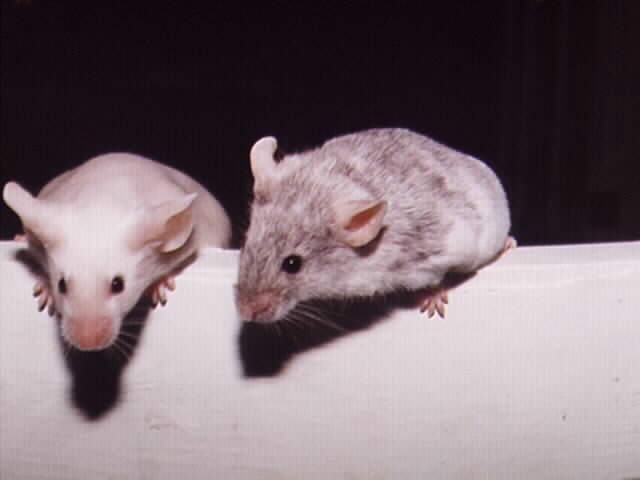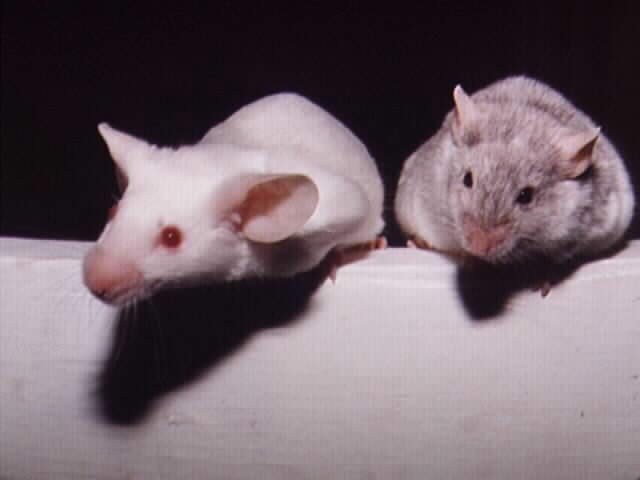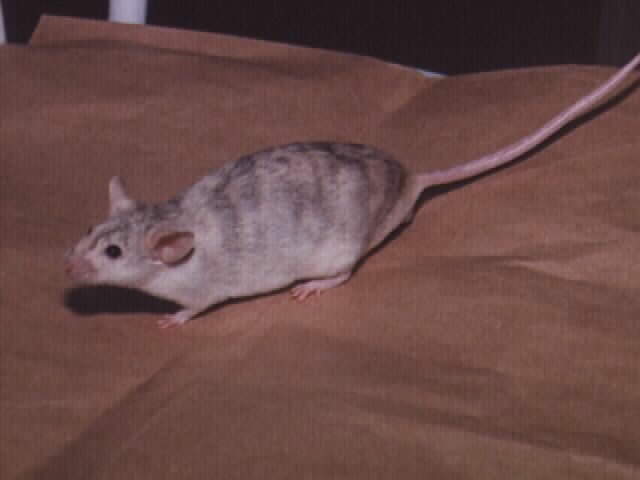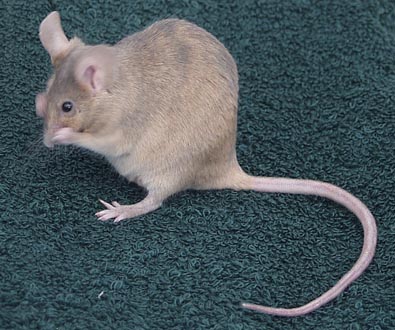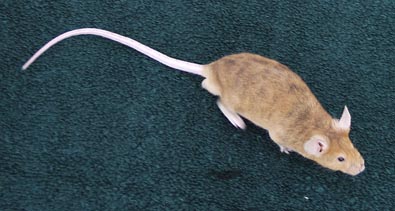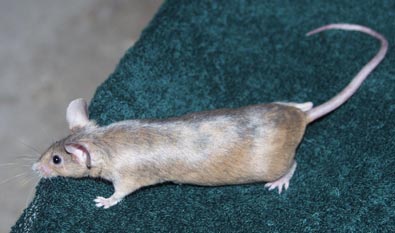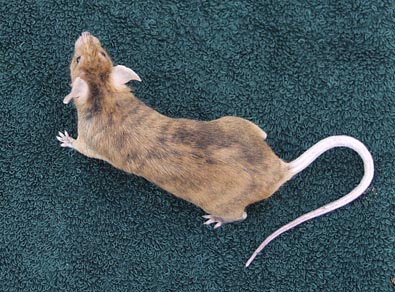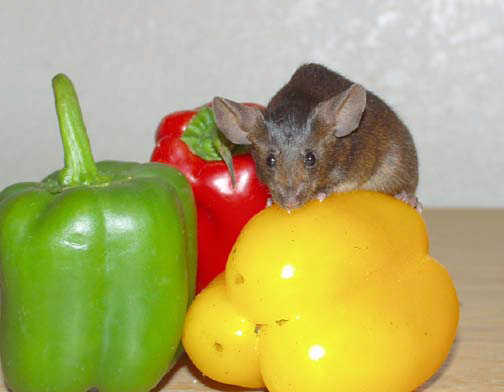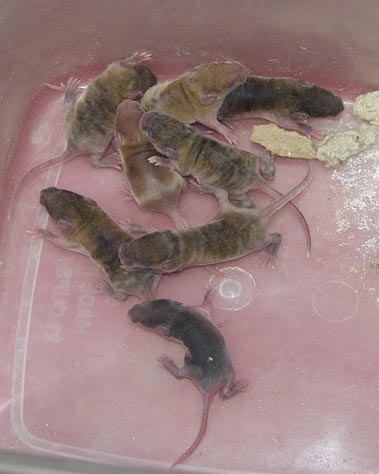One day, almost 4 years ago now, I came across a mouse in a pet shop. This little critter was a distinctive sooty gray color with clear black lines
running across it like the stripes on a tiger. The tiny 3-week-old mouse was
adorable, friendly, and appeared to be female. Just what I needed to
be a companion for my blue point girl Blinken at home.
Blinken and her new friend Duffy settled in happily. Several weeks later I
picked up Duffy and noticed the distinctive odor of male mouse. A quick peek underneath confirmed that I had once again failed sexing 101.
I quickly set Duffy up in his own home, but alas was too late. Three weeks
later Blinken presented me with a scant handful of pink peeping babies.
Quite to my surprise, most of the babies had the distinctive tiger stripes
of their dad. I was intrigued, and this interest was the springboard to
launch me on a project that has fascinated me ever since.
History
Viable Yellow (Brindle) mice were first reported in the scientific literature in 1962. They appeared suddenly in the C3H/HeJ strain of laboratory mice.
There is not much known about the history at Brindle mice within the fancy. They predate my interest in the fancy by quite a number of years. The first Brindles I came across when I first started showing were being bred by Karen Robbins. Hers came from Betty Aalseth at LabPets, a commercial breeder who bred animals for the pet shops and laboratories, in 1983. It is unknown if they originated in Betty's stock or she got them from a laboratory strain. It is entirely likely that they were one of those happy accidents that someone came across in a pet shop.
The first brindle mice were shown at an AFRMA Show by Karen Hauser
(Robbins) July 21, 1985. On July 13, 1996, they were officially
standardized. To date there has been only one Brindle to go Best In show, my own Red Brindle boy.
The Color Brindle
The AFRMA standard reads, "BRINDLE: Color 25, brindling 25. Brindle mice will be colored like brindle dogs or tigers with dark tiger-striping from
head to tail tip and to a lesser extent on the belly. Background to be a
recognized color. Eye color to match. Faults: Sooty body color to blend in
with the brindling; brindling too light or too few stripes; brindling too
heavy to lose striped affect." This description is very apt. Essentially,
they should be a colored mouse with dark stripes running across the back
and head. They also should have some stripes on the stomach, and may have a hint of them on the cars, feet, and tail as well.
Brindle mice vary greatly in the cleanness and clarity of their stripes.
They can range from mice with so much black ticking (sootiness) in their
colored areas that their stripes are barely discernible, to beautifully
clear-colored mice with stripes so light you can barely see them. Naturally,
the ideal is somewhere in between--nice distinctive dark stripes with clear
color between.
While the standard allows any recognized color as a background, in truth
there are only certain colors in which you can get brindle mice. Though the
brindling trait only shows on mice that are genetically Fawn, this still
allows for a wide variation in color.
"Type"
Type is a term used to describe the general appearance of a mouse: The way it's put together. Standards call for a large (5-6 inch without the tail)
racy mouse with elegant tulip shaped ears and a whip-like tail. Over the
last 100 years the folks in England have reached this goal by breeding
mice who truly live up to the standard.
Unfortunately, the mouse fancy in America is far behind. Not having had 100 years to selectively breed mice, most of our mice have pitiful type, not
having been bred with selection for type in mind. Most mice originating in
pet shops and many fanciers mouseries are very small (2-3 inches), have tiny round ears, and tails that look like they were stuck on as an after thought. Many also tend towards jumpy and nippy temperaments. Being a true American breed, most Brindle mice clearly fit into this description (my Duffy being a classic example).
Fortunately, this is simple to remedy. Brindle is dominant. If you breed Brindle to any other color, you should get Brindle in the
resulting litter. Ideally, breed Brindles to English mice with nice conformation. This will greatly improve the type of the resulting Brindle
babies. Doing this over several generations results in Brindle mice with
English Type (it's taken me 4 years of very limited breeding).
Genetics
Brindle mice are genetically Viable yellow (Avy). This places it in the "A" series of mouse genes. Brindle is dominant to every gene in that series except Lethal Yellow (Ay). Like Ay, Avy causes a tendancy towards obesity. This can range from slight portliness in some mice, to extreme obesity in others.
I have to add a qualifier here. Though I have been told that Brindle is dominant to every gene other than Ay in the A series, at least with my mice that is not completely true. I have found that Brindle (Avy) is not fully dominant over Tan (at). Mice that are Avy At are clearly brindle on top, but lack any striping on their bellies. When bred to each other or to non-tan selfs, tans and foxes of various colors are produced. Brindles who do have striped bellies do not produce tan/fox youngsters.
One of the fun things about brindle is that you can get it in a number of different colors. For those interested in breeding these colors, the genetics are fairly straight forward.
Fawn/Black Brindle: Orange with black stripes - Avy_
Red/Chocolate Brindle: Red with brown stripes - Avy_bb (combining brindle and chocolate)
White/Beige Brindle: White with beige stripes - Avy_cece (combining brindle and beige)
Silver Brindle: White or pale cream with black/dark gray stripes - not sure, but quite possibly Avy_cchcch (combining brindle with chinchilla)
Gold/Blue Brindle: Gold with blue stripes - Avy_dd (combining brindle with blue)
These represent the color combinations that I have tried or had pop up. There are many others that could be experimented with, and I couldn't begin to predict the results.
English Brindle
Some confusion has arisen about the genetics and health problems of Brindle mice. Much of this is caused by the fact that there are two genetically different mice which are called "brindle". To the best of my knowledge the folks in England do not have the tiger striped color we call brindle. Instead they have mice that have an interesting pattern (almost like a tortoishell). This color is lethal when seen on male mice and they die very shortly after birth. Examples of these mice do exist here in the United States, though not apparently on the west coast. Genetically, Englands mice are what the scientific literature refers to as brindle. The American version however comes much closer to looking like the brindle seen on other species.
Breeding Brindle
Producing more Brindle mice is fortunatally very simple. Brindle is dominant, so any time you breed a Brindle, you should get some Brindle babies in the resulting litter.
The best mice to keep for breeding are those that come closest to meeting
the standard. Sootiness is very difficult to eliminate, so I always prefer
to err an the side of having clear color and light or scanty stripes. I have
produced as many nice Brindles out of Brindle/non-Brindle breedings as I
have from Brindle/Brindle breedings. This is one reason Brindles are so nice to work with. Their major problem tends to be their type. (See previous
section). The easiest way to improve this is to find an English male with
exceptional type and send your females to him. My best Brindles have all been fathered by Best in Show pure English Pink-Eyed Whites and Beige Fox Satins.
The best time to make your pick out of a litter of Brindle babies is when
they are about a week old. At this point their stripes will be distinctive.
If you cull, this is when to do it. Often, babies get sooty by the time they are 4-5 weeks old. Their good color may not reappear for another 3-4
months, so it's worth taking a good long look at those week-old babies.
Due to their tendancy towards obesity, brindle mice should be bred at a realatively young age. Many people find fewer problems and higher fertility if they breed their Brindles well before they reach 3 months old. Diet can also play an important part in fertility.
Showing Brindle Mice
Brindle mice are a fairly simple color, and a good one will do well on the
show bench. Type and clarity of striping are the two major things a judge
will particularly look for.
Because all Brindle mice tend to be portly, it is important to keep them on
a nutritious diet (lab blacks) with no junk food. Stay away from grain-based diets, nuts, and dog food. This will also greatly reduce the incidence of tumors in these mice. It is an unfortunate fact that brindles are genetically predisposed towards tumors. For this reason It's also a good idea to see that brindles have access to a wheel or are kept in a large cage which encourages them to excercise. The lower their weight, the less chance of problems.
Because they are genetically fat, Brindle mice will never have the stunning type of some of the self colors. Almost all will have a bit of a pot belly at the very least. This, however, is no excuse for poor type. There is no reason Brindle can't have elegant ears, big eyes, long bodies, and well set-on whip-like tails.
Judges will closely look at the striping on Brindles. Ideally, the stripes
should be narrow and evenly spaced. They should be balanced (one side of the mouse shouldn't have more stripes than the other), and clearly defined when compared to the background color. The standard calls for stripes on the belly (though there are those of us who prefer a clear belly).
All and all, Brindle mice are an excellent variety for most fanciers. They
can be successfully kept and bred in very small numbers, and are easy to
breed with good results, so they are a good choice for novice fanciers. They
also provide an interesting challenge, come in diverse colors, and have a
complex genetic make-up, so advanced hobbyists are likely to enjoy them as well.
